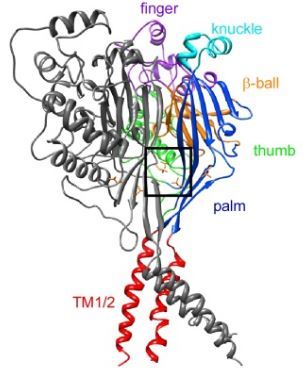Introduction of ASIC1
ASIC1, also known as amiloride-sensitive cation channel 2, neuronal (ACCN2) or brain sodium channel 2 (BNaC2), is encoded by ASIC1 gene. It belongs to the ASIC/ENaC superfamily which has been extensively studied during the past few decades because it offers numerous possibilities for therapeutic applications. Recent studies demonstrate that ASICs can form a heterodimer with ASIC1a, which is a key component in sensory neurons. Acid sensing ion channels (ASICs) are neuronal voltage-insensitive sodium channels, which are sensors of extracellular protons.
| Basic Information of ASIC1 | |
| Protein Name | Acid-sensing ion channel 1 |
| Gene Name | ASIC1 |
| Aliases | ACCN2, BNAC2 |
| Organism | Homo sapiens (Human) |
| UniProt ID | P78348 |
| Transmembrane Times | 2 |
| Length (aa) | 528 |
| Sequence | MELKAEEEEVGGVQPVSIQAFASSSTLHGLAHIFSYERLSLKRALWALCFLGSLAVLLCVCTERVQYYFHYHHVTKLDEVAASQLTFPAVTLCNLNEFRFSQVSKNDLYHAGELLALLNNRYEIPDTQMADEKQLEILQDKANFRSFKPKPFNMREFYDRAGHDIRDMLLSCHFRGEVCSAEDFKVVFTRYGKCYTFNSGRDGRPRLKTMKGGTGNGLEIMLDIQQDEYLPVWGETDETSFEAGIKVQIHSQDEPPFIDQLGFGVAPGFQTFVACQEQRLIYLPPPWGTCKAVTMDSDLDFFDSYSITACRIDCETRYLVENCNCRMVHMPGDAPYCTPEQYKECADPALDFLVEKDQEYCVCEMPCNLTRYGKELSMVKIPSKASAKYLAKKFNKSEQYIGENILVLDIFFEVLNYETIEQKKAYEIAGLLGDIGGQMGLFIGASILTVLELFDYAYEVIKHKLCRRGKCQKEAKRSSADKGVALSLDDVKRHNPCESLRGHPAGMTYAANILPHHPARGTFEDFTC |
Function of ASIC1 Membrane Protein
Acid-sensing ion channel 1 (ASIC1) is a member of the extracellular H+-activated cation channels family. ASIC1 plays a vital role in many biological functions, such as fear and pain as well as neuronal damage. Previous studies suggest that ASIC1a contributed to acid-induced rat articular chondrocytes autophagy. Meanwhile, acid-sensing ion channel 1a (ASIC1a) is a proton-gated cation channel, and neuropeptides can affect acid-induced neuronal injury by altering ASIC1a inactivation and/or steady-state desensitization.

Application of ASIC1 Membrane Protein in Literature
This article reports that the role of ASIC1a in mice using behavioral pharmacology and genetic deletion in a model of activity-induced hyperalgesia. These results indicate that ASIC1a is a key subunit in heteromeric ASICs and may be a pharmacological target for the treatment of musculoskeletal pain.
This article analyses the potential function of acid-sensing ion channels (ASICs) in retinal ganglion cell (RGC) death and the effects of inhibitors of ASICs in promoting RGC survival.
Authors in this group reveal that the inhibition of RhoA decreases the expression of ASIC1a plasma membrane. ASIC1a and RhoA colocalize in PASMC and that the activation state of RhoA modulates this interaction.
This article focuses on the expression level of ASIC1 and ASIC3 on gliomas. These results indicate that ASIC1 and ASIC3 are associated with improved survival of patients suffering from gliomas.
This article evaluates the mRNA and protein expression of LC3B-II and other autophagy-related markers are inhibited by ASIC1a-specific blocker, and trying to identify the potential mechanisms. It indicates that AMPK/FoxO3a axis plays a vital role in ASIC1a-mediated autophagy in rat articular chondrocytes.
ASIC1 Preparation Options
To obtain the soluble and functional target protein, the versatile Magic™ membrane protein production platform in Creative Biolabs enables many flexible options, from which you can always find a better match for your particular project. Aided by our versatile Magic™ anti-membrane protein antibody discovery platform, we also provide customized anti-ASIC1 antibody development services.
As a forward-looking research institute as well as a leading custom service provider in the field of membrane protein, Creative Biolabs has won good reputation among our worldwide customers for successfully accomplishing numerous challenging projects including generation of many functional membrane proteins. Please feel free to contact us for more information.
Reference
All listed services and products are For Research Use Only. Do Not use in any diagnostic or therapeutic applications.